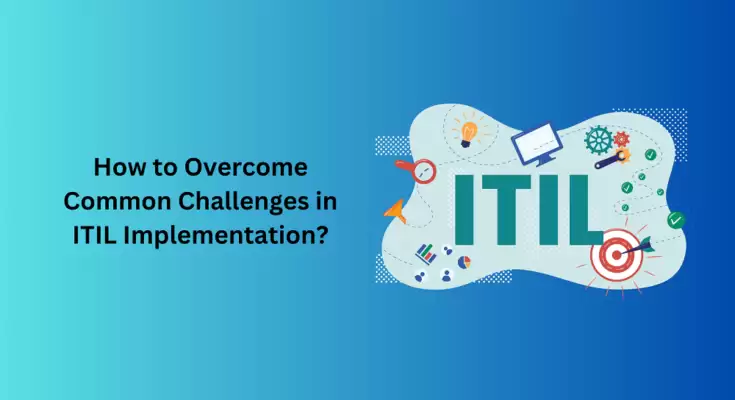The ITIL (Information Technology Infrastructure Library) framework for IT service management is now extensively used and provides an organised method for streamlining procedures, enhancing service quality, and enhancing overall company performance. Organisations are starting to know the importance of ITIL. Thus many professionals are looking to improve their skills by taking ITIL Course. Nevertheless, despite all of its benefits, ITIL deployment is not without its difficulties. In this blog, we’ll examine ITIL Advantages and Disadvantages and talk about workable solutions to them, allowing organisations to finally realise the full potential of this formidable technique.
Table of content
- Lack of Awareness and Training
- Resistance to Change
- Integration with Existing Processes
- Resource Constraints
- Measuring Success and ROI
- Advantages of ITIL Implementation
- Disadvantages of ITIL Implementation
- Conclusion
Lack of Awareness and Training
The lack of knowledge and appropriate training among IT personnel and important stakeholders is one of the biggest obstacles to ITIL implementation. Teams may have trouble coordinating their activities with the best practices of the framework if they lack a thorough grasp of ITIL concepts, terminology, and procedures. Investing in a thorough ITIL education becomes essential to solve this. Organisations may equip their teams with the knowledge and abilities they need to apply ITIL successfully by enrolling staff in authorised ITIL training.
Resistance to Change
ITIL implementation frequently necessitates significant alterations to the current organisational culture and operations. Because of their apprehension about the future, worries about their growing workloads, or misconceptions about ITIL’s advantages, employees may be resistant to these changes. Strong leadership and a transparent communication plan are necessary to overcome this reluctance. The ITIL project has to be supported by the leadership, who should articulate its benefits and highlight how they will benefit the organisation. Additionally, including workers in decision-making and offering enough assistance during the transition will promote teamwork and buy-in.
Integration with Existing Processes
It can be challenging to integrate ITIL processes with current IT operations, especially in bigger organisations with several interrelated systems. The smooth adoption of ITIL might be hampered by siloed departments and fragmented procedures. In order to solve this, organisations must carefully evaluate their present IT practices and pinpoint areas where ITIL may be successfully included. In order to avoid disruptions and facilitate a seamless change, it’s important to focus on striking a balance between introducing new ITIL procedures and maintaining existing practices.
Resource Constraints
Implementing ITIL might encounter serious obstacles due to a lack of funding, time, and experienced staff. Due to financial restrictions, organisations may be hesitant to invest in ITIL training programmes and specialised ITIL professionals. Cutting shortcuts with hiring and training, however, might result in poor execution and lower returns on investment. In order to overcome this difficulty, businesses should think about the long-term advantages of ITIL and spend enough funds to ensure successful adoption. Additionally, utilising technology and looking at affordable training choices can aid in optimising resource use.
Measuring Success and ROI
It might be difficult to assess ITIL installation progress and determine the return on investment (ROI). Although measuring the intangible advantages of ITIL, which include increased service effectiveness, decreased downtime, and higher customer happiness, may prove challenging. To solve this, organisations must create Key Performance Indicators (KPIs) that are precise, quantifiable, and in line with their unique ITIL objectives. Monitoring these indicators always will give insights into the efficiency of the ITIL implementation and allow modifications to be made to improve outcomes.
Advantages of ITIL Implementation
Despite these challenges, there are a number of advantages to ITIL that make the work worthwhile:
- Services are assured to be in accordance with business needs according to ITIL’s emphasis on service delivery and customer-centricity, which improves service quality and client happiness.
- By identifying the root causes of persistent issues, the ITIL problem-solving technique lowers downtime and business disruptions.
- ITIL promotes improved communication and cooperation between IT teams and other business divisions in order to create a more cohesive and productive workplace.
Disadvantages of ITIL Implementation
Although ITIL provides numerous benefits, enterprises should be aware of a few potential risks:
- The adoption of ITIL can be difficult and time-consuming, demanding careful planning and management to avoid overtaxing teams.
- Adopting ITIL may require considerable up-front costs for consultancy, software, and training, which makes it challenging for small businesses with few resources to do so.
Conclusion
All concerned parties must put up commitment, strategic planning, and teamwork to overcome the common implementation issues associated with ITIL. Successful ITIL implementation will be made possible by investing in ITIL courses and training, encouraging a culture of adaptation, and tracking development using well-defined KPIs. Organisations may greatly enhance their IT service management and ultimately spur commercial success by using ITIL’s benefits while minimising its drawbacks.











